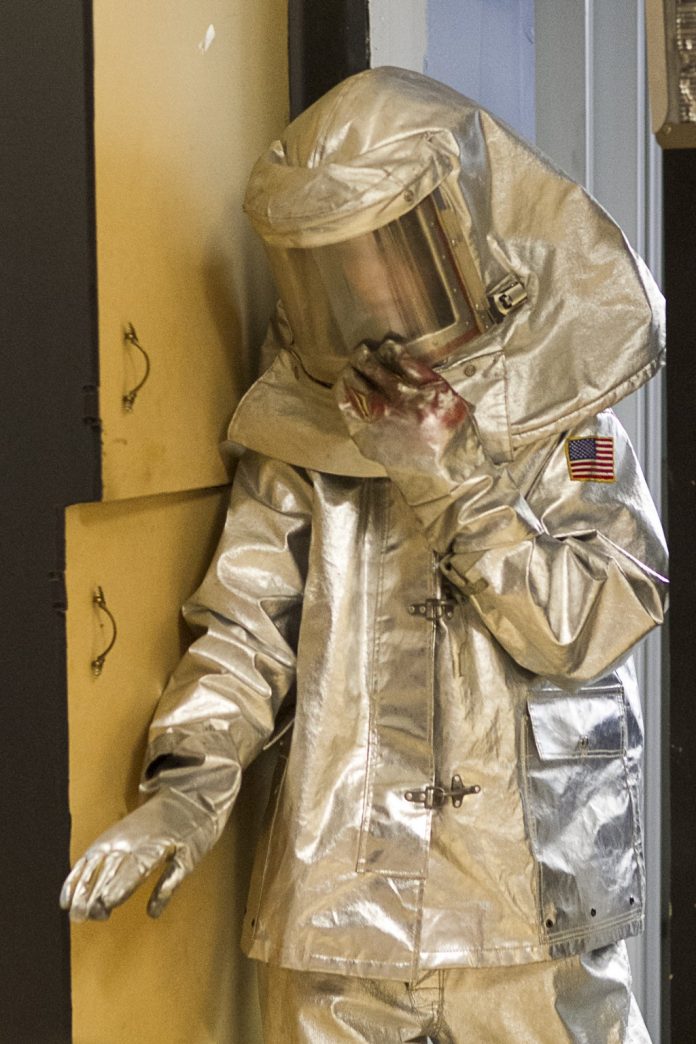The infected astronaut Leon Frame, payload specialist, is leaving the shuttle and headed to the International Space Station for medical testing. BILL ACHUFF / FOR THE TIMES
Some high school kids saved the world last Friday. It wasn’t the first time. Three of them died doing it, and it wasn’t the first time for that, either.
In late April, students at the Medical, Engineering and Aerospace Magnet School at Northeast High destroyed a mile-wide asteroid that was headed for Earth. Last week — on Friday the 13th, no less — a team of astronauts from the school’s Space Research Center, or SPARC, took a deadly virus to the International Space Station so scientists could find a cure.
It’s a good thing the virus was taken to the ISS. It got loose, and people died. Two are stuck up in space until spring. Pretty scary — even though nobody actually left the school’s Glendale Avenue building. Yes, it was all make-believe danger during a virtual mission in virtual space, but the excitement was real.
The purpose of the SPARC flight to the ISS was to study the virus under quarantined conditions, said Joe Connelly, SPARC’s new project director. “The virus has the potential to cure genetic disorders such as cystic fibrosis,” he told the Northeast Times. “However, it also has the potential to destroy the human population of the planet.”
Connelly said the team of astronauts attempted to study the virus in space “in order to minimize the risk to human life.”
So, it was kind of proactive save-the-world stuff. Well, until things started going wrong — in a big way. The flight started normally enough. The astronauts were told they were heading for the space station to make a delivery. They were not told what they were carrying.
A large and unexpected solar flare disrupted communications between Earth and the astronauts. Unknown to the astronauts, the flare also had caused some of the virus to escape from its container. When junior Leon Frame, the payload specialist, checked on it, he was infected.
More trouble occurred when the shuttle had a failed docking with the ISS and the hull was breached. The astronauts had to suit up and make repairs in space.
SPARC’s robot, Sparcy, transferred the virus to the ISS, where the astronauts realized some of it was missing and called for anyone who had contact with the container that held the virus to get to the station for quarantine. The students manning the mission control console on Earth called the astronauts. They heard someone coughing and wanted to know if the astronauts had been exposed.
“I swear I’m not infected,” came a response from space.
The ISS commander, senior Ramon Contreras, and the medical specialist, sophomore Emily Gonzalez, began testing Frame to see if he had been infected. They couldn’t tell initially and they became infected, too. Frame, Contreras and Gonzalez “died.”
The two people in the shuttle, SPARC’s veteran astronaut and commander, junior Jonathan Seitz, and the first-time pilot freshman Anthony Garcia, survived.
“They will be rescued in the two-day spring flight, along with some other surprises I have in store,” said veteran scriptwriter senior Jeremy Cruz.
Actually, something always goes wrong in SPARC’s tightly scripted space journeys. That’s part of the experience. Everybody involved knows something dangerous is supposed to happen, but not everybody knows what or when.
Cruz seems to like to make things difficult for the astronauts in his scripts. In April, one got burned by a rocket and another was exposed to radiation. Last December, a fire broke out in the space shuttle, and an astronaut was injured.
But compared to those incidents, the Friday the 13th script, with its three dead astronauts, was pretty dark. Former SPARC director Margaret Karpinski, who retired last year, said the script originally called for just one death, she said, but Cruz changed it.
This wasn’t the first time astronauts died, she said outside mission control on Friday. In years past, a team perished as members were returning to Earth, she said. Too many students to list here participated in the journey to the ISS. Here are some of the key players:
Senior Jessica Hattina served as mission spokeswoman and a robotics manager; Cruz also was flight director and flight manager. Junior Prem Patel was a robotics manager, and senior Shareef Alwarasneh was project coordinator and administration and medical manager.
Medical managers were seniors Jenny Hoang and Nicholas Worrell. Computer managers were junior Tyler Mallon and senior Christian Lattanzio. Seniors James Elder-Wilkerson and Rachel Buttry were engineering managers.
Many members of the team are veterans of past flights. Cruz, for example, has written several scripts and was flight manager in the spring. Hattina, Alwarasneh, Lattanzio and Hoang all had the same jobs during the April mission. Seitz, Buttry, Mallon and Worrell were astronauts during that mission. Seitz, who is one of the survivors, has been an astronaut several times. Carole Niemiec was the sponsor of the Robotics Division. Northeast High School nurse Anne Johnson was sponsor of the Medical Division. Connelly said each flight is really run by the students, not teachers.
“I just make sure they get what they need,” he said. ••

Space pioneers: Commander Ramon Contreras, top left, and Medical Specialist Emily Gonzalez, students at the Medical, Engineering and Aerospace Magnet School at Northeast High, simulated danger during a virtual outer space mission. BILL ACHUFF / FOR THE TIMES





